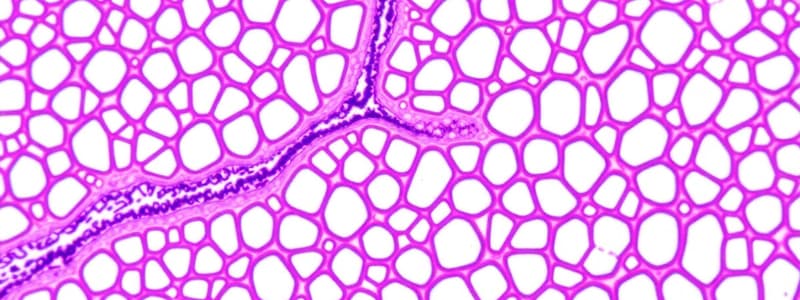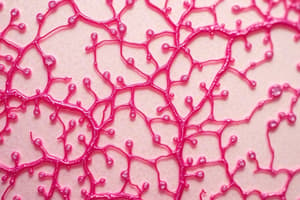Podcast
Questions and Answers
Which characteristic is LEAST likely to be associated with epithelial tissues?
Which characteristic is LEAST likely to be associated with epithelial tissues?
- Covering and lining surfaces and cavities within the body.
- Presence of glands for secretion.
- Tightly packed cells with minimal extracellular matrix.
- Abundant and visible extracellular matrix surrounding cells. (correct)
A tissue sample shows one layer of cells, all of which are in contact with the basement membrane, but some do not reach the surface. What type of epithelium is this?
A tissue sample shows one layer of cells, all of which are in contact with the basement membrane, but some do not reach the surface. What type of epithelium is this?
- Simple
- Stratified
- Transitional
- Pseudostratified (correct)
In which location would you most likely find stratified squamous epithelium?
In which location would you most likely find stratified squamous epithelium?
- Lining of the small intestine for absorption.
- Kidney tubules for filtration and reabsorption.
- Epidermis of the skin for protection against abrasion. (correct)
- Lining of the respiratory tract for secretion of mucus.
Which type of cell junction forms a permeability barrier, preventing substances from passing between cells?
Which type of cell junction forms a permeability barrier, preventing substances from passing between cells?
Which type of junction facilitates direct intercellular communication by allowing small molecules to pass between adjacent cells?
Which type of junction facilitates direct intercellular communication by allowing small molecules to pass between adjacent cells?
Which of the following describes the secretion method of a holocrine gland?
Which of the following describes the secretion method of a holocrine gland?
Which cell type is primarily responsible for producing the fibers and ground substance in fibrous connective tissues?
Which cell type is primarily responsible for producing the fibers and ground substance in fibrous connective tissues?
What role do proteoglycans play in the composition of connective tissue?
What role do proteoglycans play in the composition of connective tissue?
Which type of connective tissue is predominantly found in tendons and ligaments, providing strength and resistance to tension in one direction?
Which type of connective tissue is predominantly found in tendons and ligaments, providing strength and resistance to tension in one direction?
Intervertebral discs, which act as shock absorbers between the vertebrae, are composed of which specific type of tissue?
Intervertebral discs, which act as shock absorbers between the vertebrae, are composed of which specific type of tissue?
Which of the following is a primary function of adipose tissue, in addition to energy storage and insulation?
Which of the following is a primary function of adipose tissue, in addition to energy storage and insulation?
Which type of muscle tissue is responsible for involuntary movements within the digestive tract, such as peristalsis?
Which type of muscle tissue is responsible for involuntary movements within the digestive tract, such as peristalsis?
Neuroglial cells provide support and protection for neurons. Which of the following is NOT a typical function of neuroglial cells?
Neuroglial cells provide support and protection for neurons. Which of the following is NOT a typical function of neuroglial cells?
Synovial joints, characterized by their fluid-filled cavity, allow for a wide range of motion. Which component is primarily responsible for reducing friction between the bones within a synovial joint?
Synovial joints, characterized by their fluid-filled cavity, allow for a wide range of motion. Which component is primarily responsible for reducing friction between the bones within a synovial joint?
Following an injury, the sequence of tissue repair involves several stages. What is the correct order of these stages?
Following an injury, the sequence of tissue repair involves several stages. What is the correct order of these stages?
Simple squamous epithelium is well-suited for facilitating diffusion and filtration. Where is simple squamous epithelium commonly found?
Simple squamous epithelium is well-suited for facilitating diffusion and filtration. Where is simple squamous epithelium commonly found?
Osteoclasts and osteoblasts are both involved in bone maintenance and remodeling. What is the primary function of osteoclasts?
Osteoclasts and osteoblasts are both involved in bone maintenance and remodeling. What is the primary function of osteoclasts?
Malignant tumors are characterized by rapid and uncontrolled growth. What is the term for the process by which malignant cancer cells spread from the primary tumor to other parts of the body?
Malignant tumors are characterized by rapid and uncontrolled growth. What is the term for the process by which malignant cancer cells spread from the primary tumor to other parts of the body?
Flashcards
Epithelial Tissue Characteristics
Epithelial Tissue Characteristics
Tightly packed cells with minimal ECM, covering surfaces/cavities, and forming secretory glands.
Simple Epithelium Function
Simple Epithelium Function
One cell layer (absorption, secretion, filtration).
Stratified Epithelium Function
Stratified Epithelium Function
Multiple cell layers (protection).
Tight Junction
Tight Junction
Signup and view all the flashcards
Gap Junction
Gap Junction
Signup and view all the flashcards
Desmosome
Desmosome
Signup and view all the flashcards
Gland Definition
Gland Definition
Signup and view all the flashcards
Fibroblast Function
Fibroblast Function
Signup and view all the flashcards
Loose Connective Tissue Location
Loose Connective Tissue Location
Signup and view all the flashcards
Dense Irregular Connective Tissue Location
Dense Irregular Connective Tissue Location
Signup and view all the flashcards
Functions of Body Fat
Functions of Body Fat
Signup and view all the flashcards
Fibrocartilage Tissue Function
Fibrocartilage Tissue Function
Signup and view all the flashcards
Location of Concentric Lamellae
Location of Concentric Lamellae
Signup and view all the flashcards
Osteocytes
Osteocytes
Signup and view all the flashcards
Smooth Muscle Function
Smooth Muscle Function
Signup and view all the flashcards
Neuroglial Cells Function
Neuroglial Cells Function
Signup and view all the flashcards
Serous Membrane Function
Serous Membrane Function
Signup and view all the flashcards
Sequence of Tissue Repair
Sequence of Tissue Repair
Signup and view all the flashcards
Study Notes
- Epithelial tissues feature tightly packed cells with minimal ECM, covering surfaces/cavities, and forming glands for secretion.
Cell Shape and Layering
- Simple epithelium comprises a single layer of cells.
- Stratified epithelium consists of multiple cell layers.
- Pseudostratified epithelium appears layered but all cells contact the basement membrane.
- Squamous cells are flat in shape.
- Cuboidal cells have equal height and width.
- Columnar cells are taller than they are wide.
Epithelial Tissue Function
- Simple epithelium facilitates absorption, secretion, and filtration.
- Stratified epithelium provides protection.
- Columnar and Cuboidal epithelium are for absorption and secretion
- Squamous epithelium offers protection and aids in secretion.
Cell Junctions
- Epithelial tissue that stretches has specialized cell junctions.
- Tight junctions act as permeability barriers.
- Gap junctions facilitate intercellular communication via small pores that allow substance exchange between cytoplasms.
- Desmosomes link integral proteins, allowing extracellular fluid to pass between cells.
Glands
- Glands synthesize and secrete substances.
- Merocrine glands secrete via active transport or vesicles (exocytosis), causing the least damage.
- Apocrine glands secrete when a portion of the cell pinches off near the lumen, joining merocrine secretions.
- Holocrine glands secrete by shedding entire cells, which are then replaced by other cells.
Fibrous Connective Tissue
- Fibroblasts form fibrous connective tissue, producing protein fibers and ground substance, including collagen.
Collagen and Proteoglycans
- Collagen is a abundant protein, serving as a primary building block for skin, muscles, bones, tendons, and ligaments.
- Proteoglycans consist of GAGs bound to a core protein.
Tissue Locations
- Loose connective tissue is found beneath the epithelium of skin, lining cavities, and in the walls of hollow organs.
- Dense irregular connective tissue is located in high-tension areas like the dermis and around organs/joints.
- Dense regular connective tissue makes up tendons and ligaments.
- Dense regular elastic connective tissue is in the walls of organs that stretch, such as large blood vessels and ligaments.
- Reticular tissue is present in lymph nodes and the spleen.
- Adipose tissue is under the skin, between internal organs, and in bone cavities.
Adipose Tissue Function
- Fat provides storage, insulation, organ protection, hormone production, and nutrient absorption.
Intervertebral Discs
- Intervertebral discs consist of fibrocartilage tissue, providing strength and elasticity for shock absorption.
Tendons
- Tendons connect muscle to bone, transmitting force generated by muscle contraction for movement.
Concentric Lamellae
- Concentric lamellae are found in compact bone around the Haversian canal.
Osteocytes
- Osteocytes are surrounded by ECM, mostly inactive, but involved in bone maintenance
Muscle Tissue
- Smooth muscle, found in the digestive tract, facilitates involuntary movement of food.
Neurons
- Nerve cells (neurons) contain an axon.
- Unipolar neurons have one process (one axon).
- Bipolar neurons have two processes (one axon and one dendrite).
- Neuroglial cells support and protect neurons via various functions.
Freely Moveable Joints
- Freely moveable joints are synovial joints, which have a wide range of motion due to a fluid-filled joint cavity and cartilage.
Serous Membrane
- Serous membranes protect internal organs from friction with a thin, slippery layer that lines cavities and covers organs to lubricate them.
Inflammation
- Symptoms of inflammation include redness, swelling, pain, heat, and fever.
Tissue Repair
- The sequence of tissue repair involves hemostasis (blood clotting), inflammation, proliferation (tissue growth), and remodeling (maturation).
Sutures for Large Wounds
- Suturing a large wound closes the gap, stops bleeding, minimizes scarring, prevents infection, and reduces tension on the wound site.
Epithelium Location
- Simple squamous epithelium lines blood vessels, air sacs in the lungs, and body cavities, facilitating substance passage.
- Simple cuboidal epithelium lines kidney tubules, glandular ducts, and the ovary surface, involved in secretion and absorption.
- Simple columnar epithelium lines the digestive tract, gallbladder, and parts of the female reproductive tract, specialized for absorption and secretion.
- Stratified squamous epithelium is on the skin's outer layer (keratinized) and lines the mouth, esophagus, and vagina (non-keratinized), protecting against abrasion.
- Pseudostratified columnar epithelium lines the respiratory tract (nasal cavity, trachea, bronchi), with cilia to move mucus.
- Transitional epithelium is in the urinary system (bladder, ureters, urethra), allowing expansion and contraction.
Cell Types
- Myocytes (muscle cells) contract to generate force for movement.
- Osteoblasts form bone.
- Osteoclasts break down bone.
- Macrophages destroy pathogens, dead cells, and debris.
- Stem cells develop into different cell types based on the body’s needs.
Muscle Types
- Skeletal muscle enables voluntary movement.
- Smooth muscle is involuntary and found in internal organs.
- Cardiac muscle is specific to the heart, pumping blood.
Gland Types
- Exocrine glands release materials from inside to the outside.
- Endocrine glands engulf materials from the outside.
Cartilage
- Cartilage protects bones and joints, reducing friction, absorbing shock, and providing flexibility.
- Found between bones, in the ear, nose, and parts of the respiratory tract
- Edema is swelling due to fluid buildup in tissues.
Scars and Keloids
- Scars form from granulation tissue, appearing red to white as capillaries are forced out.
- Keloids are raised, firm scars that grow beyond the injury boundaries.
Cancer Types
- Malignant cancers are cancerous and grow quickly.
- Benign cancers are non-cancerous, grow slowly, and do spread.
Metastasis
- Metastasis is the spread of cancer cells from the original tumor to other body parts.
Studying That Suits You
Use AI to generate personalized quizzes and flashcards to suit your learning preferences.




